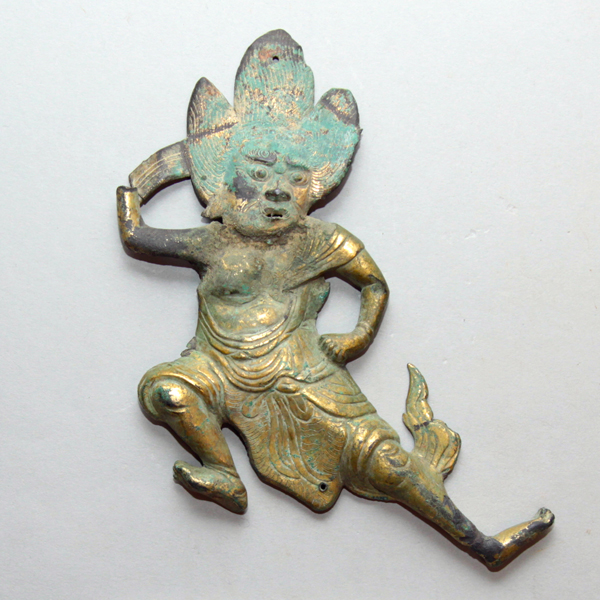祈りのかたち―山岳信仰と末法思想―
-

重要美術品 押出蔵王権現像
奈良県天川村 大峯山頂遺跡出土 平安時代・10~12世紀平成館 考古展示室
2022年9月21日(水) ~ 2023年3月12日(日)奈良時代の終わりから平安時代にかけて、山林で修行する僧によって広められた山岳信仰は、わが国の古代社会において独自の発展を遂げた信仰形態のひとつであり、やがて修験道へと展開していきます。本展示では、山岳信仰の代表的な霊場として著名な奈良県大峯山頂や栃木県日光男体山の山頂の出土品を展示し、山岳信仰で用いられた品の種類や使われ方などを紹介します。
| 指定 | 名称 | 員数 | 作者・出土・伝来 | 時代・年代世紀 | 所蔵者・寄贈者・列品番号 | 備考 | |
| おすすめ | 重文 | 蔵王権現像 | 1面 | 奈良県天川村 金峯山出土 | 平安時代・10~12世紀 | 奈良・大峯山寺蔵 | |
| 蔵王権現懸仏 | 1面 | 奈良県天川村 大峯山頂遺跡出土 | 平安時代・10~12世紀 | E-15276 | |||
| 重文 | 蔵王権現像残欠 | 1躯 | 奈良県天川村 大峯山頂遺跡出土 | 平安時代・10~12世紀 | 奈良・大峯山寺蔵 | ||
| 重文 | 蔵王権現像残欠 | 1躯 | 奈良県天川村 大峯山頂遺跡出土 | 平安時代・10~12世紀 | 奈良・大峯山寺蔵 | ||
| おすすめ | 重美 | 押出蔵王権現像 | 1個 | 奈良県天川村 大峯山頂遺跡出土 | 平安時代・10~12世紀 | E-19973 | |
| 重文 | 銅塔鋺 | 1合 | 栃木県日光市中宮祠 日光男体山頂遺跡出土 | 平安~鎌倉時代・10~13世紀 | 栃木・二荒山神社蔵 | ||
| 重文 | 瑞花双鳥八稜鏡 | 4面 | 栃木県日光市中宮祠 日光男体山頂遺跡出土 | 平安~鎌倉時代・10~13世紀 | 栃木・二荒山神社蔵 | ||
| 重文 | 瑞花八稜鏡 | 1面 | 栃木県日光市中宮祠 日光男体山頂遺跡出土 | 平安~鎌倉時代・10~13世紀 | 栃木・二荒山神社蔵 | ||
| 重文 | 花枝飛鳥鏡 | 1面 | 栃木県日光市中宮祠 日光男体山頂遺跡出土 | 平安~鎌倉時代・12~13世紀 | 栃木・二荒山神社蔵 | ||
| おすすめ | 重文 | 錫杖頭 | 2個 | 栃木県日光市中宮祠 日光男体山頂遺跡出土 | 平安~鎌倉時代・10~13世紀 | 栃木・二荒山神社蔵 | |
| 重文 | 錫杖頭 | 2個 | 栃木県日光市中宮祠 日光男体山頂遺跡出土 | 平安~鎌倉時代・10~13世紀 | 栃木・二荒山神社蔵 | ||
| おすすめ | 重文 | 三鈷鐃 | 1個 | 栃木県日光市中宮祠 日光男体山頂遺跡出土 | 平安~鎌倉時代・10~13世紀 | 栃木・二荒山神社蔵 | |
| 重文 | 独鈷杵 | 2個 | 栃木県日光市中宮祠 日光男体山頂遺跡出土 | 平安~鎌倉時代・10~13世紀 | 栃木・二荒山神社蔵 | ||
| 重文 | 三鈷杵 | 1個 | 栃木県日光市中宮祠 日光男体山頂遺跡出土 | 平安~鎌倉時代・10~13世紀 | 栃木・二荒山神社蔵 | ||
| 重文 | 二又矛 | 11個 | 栃木県日光市中宮祠 日光男体山頂遺跡出土 | 平安~鎌倉時代・10~13世紀 | 栃木・二荒山神社蔵 | ||
| 重文 | 鉄剣 | 3個 | 栃木県日光市中宮祠 日光男体山頂遺跡出土 | 平安~鎌倉時代・10~13世紀 | 栃木・二荒山神社蔵 | ||
| おすすめ | 重文 | 鉄矛 | 3本 | 栃木県日光市中宮祠 日光男体山頂遺跡出土 | 平安~鎌倉時代・10~13世紀 | 栃木・二荒山神社蔵 | |
| 重文 | 短刀 | 3本 | 栃木県日光市中宮祠 日光男体山頂遺跡出土 | 平安~鎌倉時代・10~13世紀 | 栃木・二荒山神社蔵 | ||
| 重文 | 刀子 | 5本 | 栃木県日光市中宮祠 日光男体山頂遺跡出土 | 平安~鎌倉時代・12~13世紀 | 栃木・二荒山神社蔵 | ||
| 重文 | 鉄鈴 | 5個 | 栃木県日光市中宮祠 日光男体山頂遺跡出土 | 平安~鎌倉時代・10~13世紀 | 栃木・二荒山神社蔵 | ||
| 重文 | 銅鈴 | 5個 | 栃木県日光市中宮祠 日光男体山頂遺跡出土 | 平安~鎌倉時代・10~13世紀 | 栃木・二荒山神社蔵 | ||
| 重文 | 鉄鐸 | 5個 | 栃木県日光市中宮祠 日光男体山頂遺跡出土 | 平安~鎌倉時代・10~13世紀 | 栃木・二荒山神社蔵 | ||
| 重文 | 火打鎌 | 5個 | 栃木県日光市中宮祠 日光男体山頂遺跡出土 | 平安~鎌倉時代・10~13世紀 | 栃木・二荒山神社蔵 | ||
| 重文 | 銅印 | 2個 | 栃木県日光市中宮祠 日光男体山頂遺跡出土 | 平安~鎌倉時代・10~13世紀 | 栃木・二荒山神社蔵 | ||
| 重文 | 経軸端 | 2個 | 栃木県日光市中宮祠 日光男体山頂遺跡出土 | 平安~鎌倉時代・10~13世紀 | 栃木・二荒山神社蔵 | ||
| 重文 | 銅銭 | 20枚 | 栃木県日光市中宮祠 日光男体山頂遺跡出土 | 平安~鎌倉時代・10~13世紀 | 栃木・二荒山神社蔵 | ||
| 重文 | 細口瓶 | 2個 | 栃木県日光市中宮祠 日光男体山頂遺跡出土 | 平安~鎌倉時代・10~13世紀 | 栃木・二荒山神社蔵 | ||
| 重文 | 広口壺 | 2個 | 栃木県日光市中宮祠 日光男体山頂遺跡出土 | 平安~鎌倉時代・12~13世紀 | 栃木・二荒山神社蔵 | ||
| 重文 | 坏 | 2個 | 栃木県日光市中宮祠 日光男体山頂遺跡出土 | 平安~鎌倉時代・12~13世紀 | 栃木・二荒山神社蔵 | ||
| 重文 | 埦 | 2個 | 栃木県日光市中宮祠 日光男体山頂遺跡出土 | 平安~鎌倉時代・10~13世紀 | 栃木・二荒山神社蔵 | ||
| 重文 | 手捏土器 | 2個 | 栃木県日光市中宮祠 日光男体山頂遺跡出土 | 平安~鎌倉時代・12~13世紀 | 栃木・二荒山神社蔵 |
